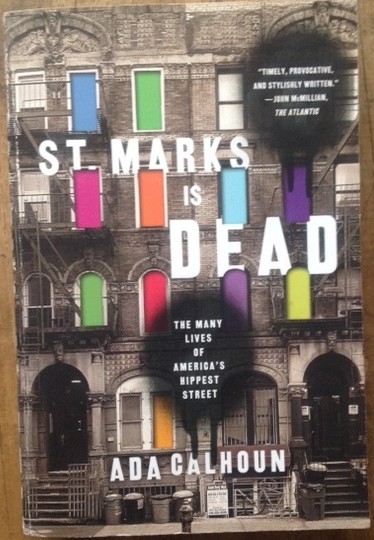Inspiring Older Readers
 posted on 24 Nov 2020
posted on 24 Nov 2020
St. Marks Is Dead: The Many Lives of America's Hippest Street by Ada Calhoun
I’m constantly fascinated by the way different parts of big cities seem to develop an identity and life of their own. It’s especially interesting when a particular area or set of streets constantly morphs into and out of fashion – becoming bandit territory in one decade or cool, artistic destination in the next. What’s always true however is that once a location has developed a less than salubrious reputation, that shadow continues to colour the public perception of the place - come what may.
Author Ada Calhoun was born and spent time living on St. Marks Place and grew used to people responding with a mix of shock, dismay, sympathy and envy whenever she mentioned the fact. This kind of exaggerated response to her origins stems from the New Yorkers’ perceptions of this part of what has become known as the East Village – a location adjacent to the Bowery, that other neighbourhood legendary for its crime and poverty.
What Calhoun documents in meticulous detail is the way St. Marks evolved over time, becoming, by the 1960s, a place thought to be the heart of bohemia, imbued with that mysterious quality of ‘cool’. Indeed, fascinatingly, Calhoun traces mentions of St Marks in pop culture and literature and provides us with a pretty exhaustive index of these at the end. But, she goes on to explain, every phase of St Marks’ changing identity is greeted by the inhabitants as if they are witnessing its swan song – ‘St Marks is dead’ they are likely to say ’you should have been here when it was at its peak!’
Calhoun doesn’t hang about in her historical survey of the comings and goings and, if there’s a criticism to be made, it’s the failure to develop some of the stories that seem to deserve more time and attention. The review of the book back in 2015 by Kirkus captures this rather helter-skelter approach:
“In quickly paced, anecdotal fashion, Calhoun connects the dots between Emma Goldman and Abbie Hoffman, Charlie Parker and the Velvet Underground, those who occupied the neighborhood during different decades but sustained its character as kindred spirits. While readers looking for a more thorough documentation of the Beats or CBGB might consider the narrative a little hit-and-run..”
One of the features of St. Marks is the way it is constantly at the forefront of radicalism or extremes of innovation. Calhoun paints a picture of a neighbourhood that at various times has been the chosen location for a wave of radical evangelism, radical left-wing politics, artistic and literary outsiders and a fierce sense of identity that offers a home to political idealists and activists.
John McMillan writing in The Atlantic magazine notes the way in which the modern incarnation of St. Marks retains this ‘special’ identity and defies the doomsayers who are always looking for signs of its demise:
“Far from being “dead,” St. Marks Place—which, as Calhoun writes, “will probably always elude true respectability”—remains a lively site of tremendous cultural mixing. Young people still gather there, whether to watch soccer, sing karaoke, or revel in what’s left of its gritty mystique and low-down allure. Quirky specialty shops abound, and immigrants hock their wares on the sidewalk. A recent influx of Japanese restaurants lends the neighborhood a “Little Tokyo” vibe, and rumor has it that the St. Marks Hotel still offers hourly rates on its rooms. None of this is likely to mollify gentrification’s most strident opponents, but then again, they probably didn’t grow up on St. Marks when it was characterized by such misery, dysfunction, and human wreckage.”
What is missing from this book is more of Ada Calhoun herself. Born in the neighbourhood and living there for much of her life, I would have welcomed more of her own story and more of her own experience. What we have in the end is the biography of a city district, fascinating and thorough, but oddly lacking the human, personal experience.
I think the book is only available in a paperback edition and copies aren’t as cheap as you’d like but I think it would be an investment that wouldn’t disappoint.
Terry Potter
November 2020